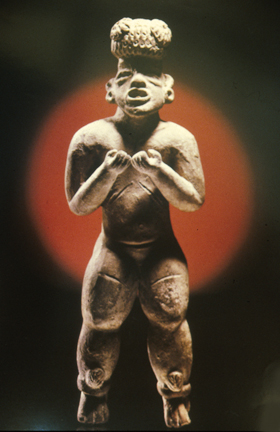This standing Olmec figure in terra cotta features highly naturalistic rendering, and may represent a praying figure and/or a player of the ball game. The nude figure shows detailed treatment of the ankle ornaments and hair style. During the Preclassic period, architectural remains of ball courts and pyramids were found at La Venta. The layout of the ceremonial complex was done according to astronomical observations, another characteristic of later Mesoamerican cultures. The ball court was for playing tlachtli, the ritual game which used a rubber ball, and a clearly demarcated playing field, with stands for spectators. This may represent a ball player.
By 400 BCE the Olmec population centers were destroyed by warfare and were abandoned to the jungles, but their artistic tradition lingered. By 250 BCE, during the Classic period, new ceremonial centers were built in the Olmec heartland of Veracruz. The next image will show the evolution of this style.

Olmec Standing Figure from Xochipala, Earthenware
Preclassic period, 1,000-800 BCE


